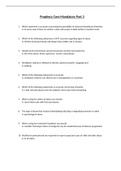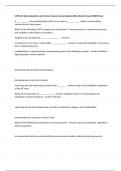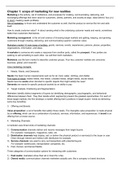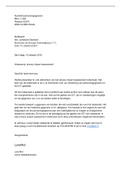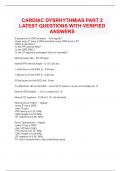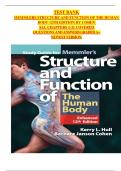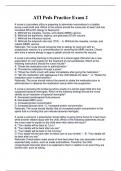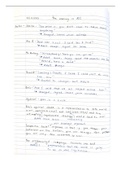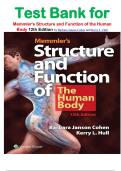Introduction
Hello Students of WGU C215!
Something that’s been annoying me is the outline, if anyone knows how to change it so
that only the “sections” (the bold and underlined parts only) show up (and not the chapters),
yeah that’d be great if you could do that please, idk how to do it.
I wanted to create this document for those who may be wanting some help understanding
Management Operations better, to prepare for the upcoming final exam, to act as a platform for
all of us to discuss some strategies to better understand and retain the material both in
preparation for the exam as well as for after graduating.
Some general rules to make this document more effective. Also, please comment, suggest
things, and add your own stuff to the document. Rework the document in a way that would
make it more useful for you.
This isn’t designed to be a dead doc , it should be changed a
lot so don’t hesitate if you’ve got questions or whatever to just
add them in the comments section or as a sub-bullet point.
Don’t just delete or alter the actual document directly, use the ‘suggesting’ tool first, so
that if others would like to have a discussion, they have the opportunity to. The
suggesting tool looks like this, and is located right below the big blue ‘Share’ buttonThe
suggesting tool looks like this
o (Small caveat) since this doc is so new if you work on a topic that no one has
worked on yet, just start writing and studying and don’t worry about suggesting. If
this doc ends up being used a lot in the future this rule will be more important.
Another very helpful tool is the commenting option
o If you’re familiar with the ‘Review’ tab on Microsoft Word, it’s very similar
This is also a *very* informal platform for us all to better understand the material, so let’s
have fun, be respectful, and get some stuff done
Let’s kick this class’ ass
,Miscellaneous
I wouldn’t just use this document as a passive document. The purpose of it is to provide an
interactive format to help expose all of us to the information and material in different ways. If you
see something that you want to address and think might be off, well comment on it and discuss
grounds to change it not just for your benefit but also for the benefit of students who happen to
use it after we finish using it.
The real purpose of creating this document is to add value to students’ study efforts, so
everyone IMO has the responsibility to max out the value this document can provide. Best
wishes to everyone!!
So the first thing that I would do is take a pre-assessment because the coaching report attached
is going to be very helpful in telling you where you need to focus your study efforts. I think that
other students will have slightly different coaching reports so don’t treat this as ‘the gospel’, but I
think it works as a general direction to follow.
Personally, I would just take it as though it’s the actual exam; there was a strategy I used where
if I wasn’t sure about a particular question I just wouldn’t answer it. But IMO, if I answer a
question and I have the right intuition about that question about what’s right and wrong I take
the same intuition into the exam (but in those cases where you’re really just guessing, write
those questions down and review them later) and leverage the fact you have a good intuition
about that topic.
The following is the format that my pre assessment questions followed, with the percentage
weight of the sub-topic listed and the chapters associated with the sub-topic. I also ordered it
with the most heavily weighted topics first
21.5% Planning Chapters 13, 14, 16, and Supplement D
16.0% Quality Management Methods Chapters 5 + 6
14.3% Capacity Planning + Location Analysis Chapter 9
11.4% Process Selection + Layout Chapters 3 + 10
11.0% Supply Chain Chapter 4
11.0% Operating Efficiency Chapters 7 + 15 and Supplement B
9.00% Work System Design + Scheduling Chapter 11
5.70% Management Chapter 12
The following list is ordered based on what I think the most efficient way to study the text would
be, where I found each chapter approximate percentage influence on the results they would
make on the test. What I did is counted the amount of “sections” in each chapter (when you goto
wiley and click on a chapter, there are a number of sections you have to click through----
Those). For example, Chapter 5 has 10 sections and is part of +the quality management
, methods topic, Chapter 6 has 3 sections and is also part of the quality management methods,
so if I multiply the percentage of the test covered by quality management methods (16%) by the
weight of each of the two chapters by how many sections there are in each chapter (10 and 3)
divided by the total sections the topic covers (13) Chapter 5 covers 12.3% of the exam (16% *
10/13 = 12.3%)
Then, because I wanted to also order this list by how to most efficiently study, I knew that
some chapters would more easily produce results because they were shorter and require less
time to go over. A good example is comparing chapter 3 and chapter 11. Chapter 3 using the
previously explained method covers 6.84% of the exam and chapter 11 covers 9%, so without
accounting for the length of the chapters chapter 11 would take priority over chapter 3, however,
there are only 3 sections in chapter 3 and there are a whopping 10 sections in chapter 11. So
the final step I did was divide the percentage of the exam each chapter prepares us for, by the
amount of sections in the chapter, to find a sort of “information density” measurement. So for
Chapter 3 that would be 6.84%/3 sections = 2.28 info density (ID) and Chapter 11 would be
9%/10 sections = 0.90 ID.
All this is supposed to do is help with the decision to study one chapter or topic over
another based off the results you have from your pre assessment coaching report.
*************************************************************************************************************
Process Selection + Layout Ch 03 = 2.28 ID (Information Density)
Ch 10 = 2.28 ID
Supply Chain Ch 04 = 1.83 ID
Operating Efficiency Ch 15 = 1.85 ID
Ch 07 = 1.83 ID
Planning Ch 13 = 1.66 ID
Ch 14 = 1.65 ID
Ch 16 = 1.65 ID
Capacity Planning + Location Analysis Ch 09 = 1.59 ID
Management Ch 12 = 1.43 ID
Quality Management Methods Ch 05 = 1.23 ID
Ch 06 = 1.23 ID
Work System Design + Scheduling Ch 11 = 0.90 ID
*************************************************************************************************************
Again, for each of us we are going to need to make a decision based off our pre-
assessment results to either spend more time studying one topic or another, but if you got a 0%
on both process selection + layout and management, I would follow this format and prioritize
studying the former more than the latter, just because it would be a better use of your time by a
factor of ~ 1.6. In my case I did pretty poorly in process selection and layout, so I’ll be spending
quite a lot of time on that since it’ll produce the best results concerning my final exam.
Capacity Planning, Location Analysis

